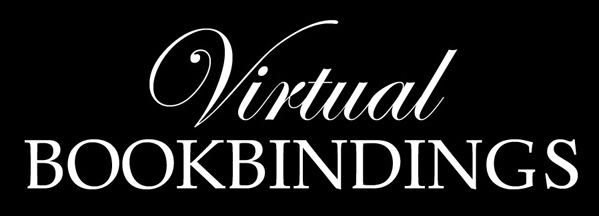

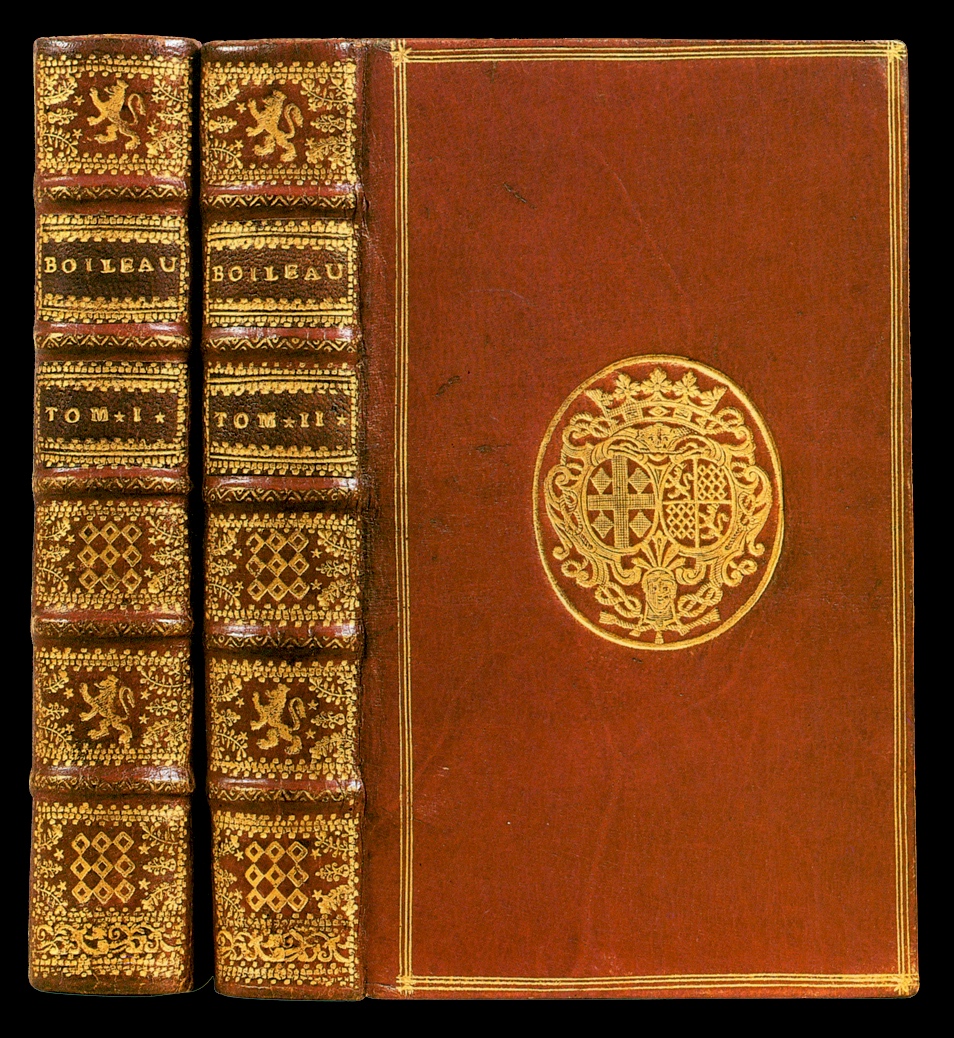
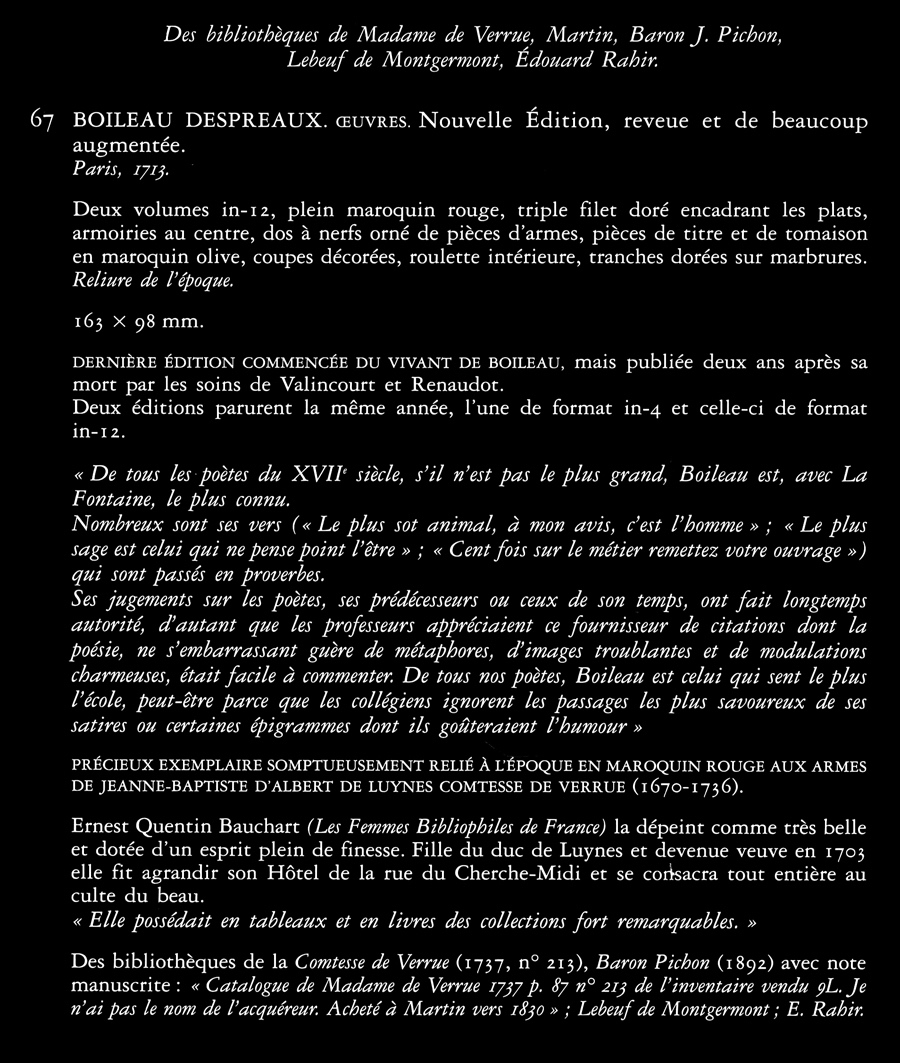
| The binding shown above is found in a 1999 LIBRAIRIE SOURGET - MANUSCRITS ET LIVRES PRECIEUX - CATALOGUE N° XX, pages 148-149, lot 67. We might imagine that Madame la Comptesse de Verrue (as she is called in the Catalogue of her paintings that went up for auction on Wednesday 27th of March 1737 some 4 months after her death on the 18th of November 1736) might have snapped up this new edition of Boileau and had it bound by Boyet soon after, at any rate we know that it was made at least as late as 1713 and this gives us a small window into the style of her bindings at that time. |
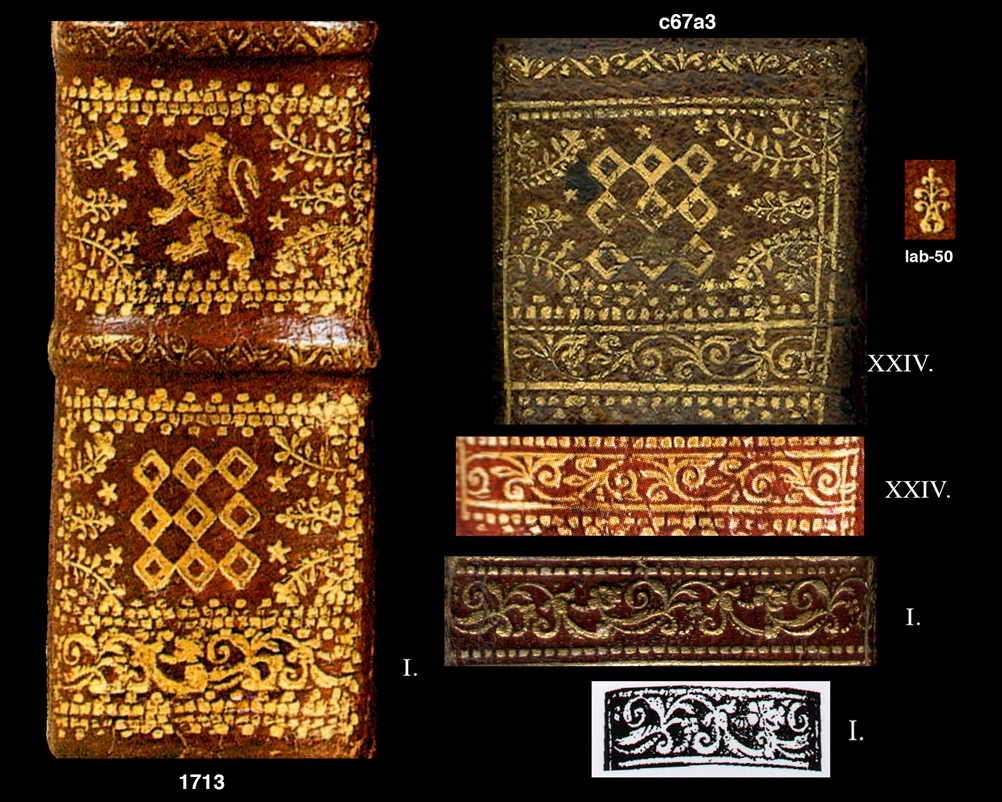
| In Comparative Diagram 1, we see that the palette at the bottom of the spine of this 1713 binding is a Type 1 in the catalogue of Isabelle de Conihout & Pascal Ract-Madoux, Reliures françaises du XVIIe siècle, Paris, 2002. I show in this same diagram the spine of British Library example c67a3 that we have looked at on the previous page, the intrest here is that both of these bindings have the same decorative imprint lab-50 employed in exactly the same way. The palette however of c67a3 is a XXIV example... now we might speculate therefore that c67a3 was bound after 1713 due to the fact that Boyet used palette 1 often in the past where as palette XXIV appears rather rare and is a possibly later developement. If we continue to catalogue all of the bindings from the collection of Madame la Comtesse, we will eventually unravel these mysteries. |
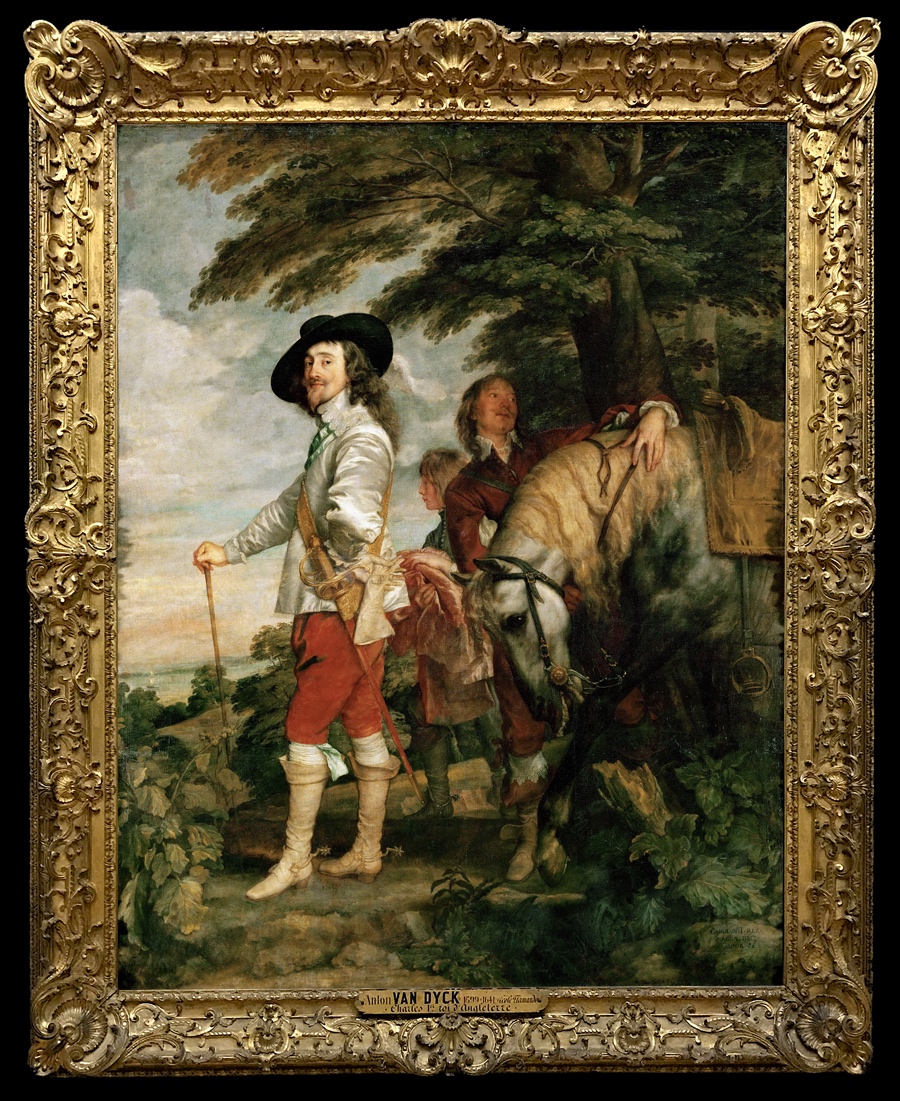
| Speaking of mysteries I want to expose another that revolves around Madame la Comtesse de Verrue. In a number of places, such as the Wikipedia article about her, I have come across this statement in regards to her passion for collecting paintings... "She even owned a Portrait of Charles I of England by Van Dyke". Today I found a similar reference in an article in the Tate Papers. They begin their story like this... |
| Since the early eighteenth century France has been home to one of the finest portraits ever painted on British soil, a portrait of King Charles I by Sir Anthony Van Dyck, under the title Charles I at the Hunt c.1635 (or, in French, Le Roi à la chasse), it has been one of the jewels of the Louvre collection in Paris since the museum opened in 1793... moreover, it has been pointed out frequently that the composition of Rigaud's most famous work, the Portrait of Louis XIV 1701, is identical to that of Charles I at the Hunt by Van Dyck. It is probable that the Van Dyck painting was in Paris at the end of the seventeenth century, although it has not yet been ascertained whether Rigaud had access to it. (The painting is known to have been in the Paris collection of the Countess of Verrue in 1736, although its location before that date is not known.) While it is true that the pose of Louis XIV, which is very choreographic, closely resembles other princely portraits of the seventeenth century, such as Louis-Ferdinand Elle's Portrait of Louis XIV 1665 (Musée des Beaux-Arts, Metz), the correspondence between the kingly portrait by Rigaud and Van Dyck's earlier painting is sufficiently striking to be worthy of note. |
|
So you would think the history of all this is well known however when you go to the Louvre and dig up this painting of Charles I, you discover that the experts at the Louvre don't know anything about it... "Not kept by Charles I since it does not feature in any inventory of his collections and no doubt taken out of England in the 17th century. Documented in France before 1738. Acquired from the comtesse Du Barry by Louis XVI, 1775" INV. 1236... there is a conspiracy here somewhere I am sure... where did the comtesse Du Barry get it? I decided to check the 1737 auction catalogue of the paintings of Madame la comtesse Verrue. This is not easy to find, there cannot be many copies as it is a hand written list... Fortunately the whole thing can be found at archive.org (click here to see this amazing document) There are 181 lots in the list which includes multiple paintings per lot, perhaps as many as 300 paintings in all some of which were sold at the equivalent of hundreds of thousands of todays dollars such as lot 73 a painting by Wouwerman sold for 1400 livres nearly equal to three times the yearly salery of a skilled worker, in todays money thats nearly 200 thousand dollars, another lot, No. 69 sold for 1460 a painting by David Teniers the Younger, the item note says "une grande tentation une femme vetue de noir" I actually found this searching with Google, in a book entitled Sheltering Art: Collecting and Social Identity in Early Eighteenth-century Paris By Rochelle Ziskin with the exact reference |

| Following this lead I discover that within Rochelle Ziskin's book we find the whole story of the Charles I painting! The staff at the Louvre have yet to read this book! It turns out that it was probably James II who brought the Charles I portrait to France when he went into exile there in 1690 "in July 1690, James returned to France where he spent the rest of his life in exile at Saint-Germain, protected by Louis XIV" (click here to read his story on Wikipedia)... here is something I bet you didn't know... when James II died in France... |
|
"He died aged 67 of a brain haemorrhage on 16 September 1701 at Saint-Germain-en-Laye. James's heart was placed in a silver-gilt locket and given to the convent at Chaillot, and his brain was placed in a lead casket and given to the Scots College in Paris. His entrails were placed in two gilt urns and sent to the parish church of Saint-Germain-en-Laye and the English Jesuit college at Saint-Omer, while the flesh from his right arm was given to the English Augustinian nuns of Paris.
The rest of James's body was laid to rest in a triple sarcophagus (consisting of two wooden coffins and one of lead) at the Chapel of Saint Edmund in the Church of the English Benedictines in the Rue St. Jacques in Paris, with a funeral oration by Henri-Emmanuel de Roquette. James was not buried, but put in one of the side chapels. Lights were kept burning round his coffin until the French Revolution." |
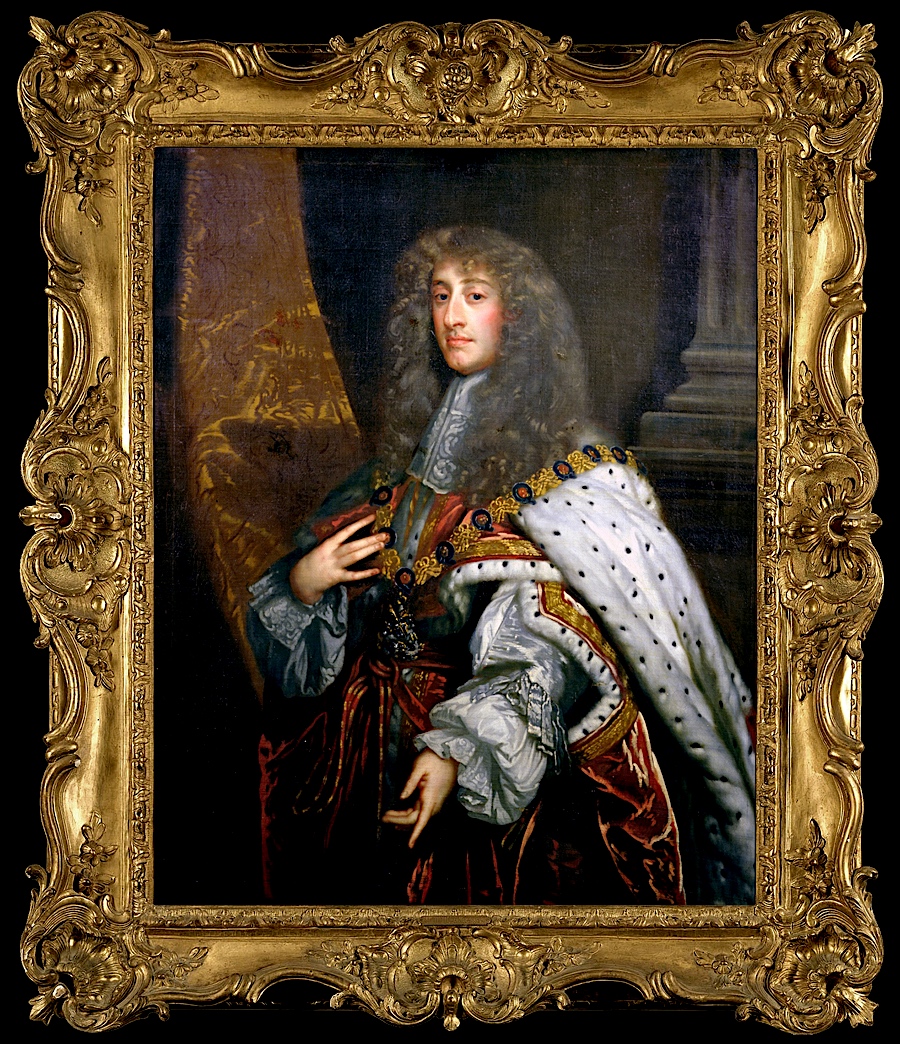
| Now you are still wondering how Madame la comtesse de Verrue acquired this painting. I decided to write to Rochelle Ziskin to learn more about this and she kindly replied with this information... |
|
"Here is the passage on Van Dyck's Charles I in chapter 2, p. 60: Above all, however, the Grande Galerie des Carmes was a site for the display of the countess's largest paintings. Above a dado, walls were lined with red-orange "damask from Turin." Set in the most privileged position, opposite the fireplace and facing the entry, was her most valuable painting - Van Dyck's celebrated portrait of Charles I (color plate x). It may have come to France with James II, who died in exile at Saint-Germain-en-Laye in 1701. [note 116] If so, Verrue might have acquired it shortly after her grandniece wed a grandson of James II in 1720.[note 117] In 1736, Verrue named that grandniece her universal heir, but kept the prize portrait for her friend the comte de Lassay. La Comtess de Verrue bequeathed it to the comte de Lassay (by that time he was actually the marquis de Lassay. Her bequests were distributed in early 1737. Lassay died in 1750. Here's a note explaining what happened to his paintings. He and his wife (who was also his aunt) had no children. p. 299 n. 134: Mme de Lassay was her husband's sole heir, but they planned to divide the estate into two equal parts. Half was to pass to grandnephew Louis-Léon-Félicité, comte de Lauraguais, later duc de Brancas (17331824), and half to grandnephew Jean, comte de La Guiche (171970). In 1755, Mme de Lassay donated to Lauraguais the use of the Hôtel de Lassay during his lifetime, with thirty paintings "by several grandes maîtres," plus the overdoor paintings. Lauraguais started selling the paintings -- not in a single sale, but over time. So he may have sold it to the comte or comtesse du Barry (or perhaps someone else). It is gone by the time of the "marquis de Lassay" sale of 1775. Here is the note on Guiffrey's contention that the Van Dyck Charles I must have come to France via James II. [note 116.] Jules Guiffrey stated that it was [in the collection of James II] but offered no evidence, in "Portrait of Charles I," in Famous Paintings as Seen and Described by Famous Writers, ed. and trans. Esther Singleton (New York: P. F. Collier & Son, 1911), 114. Francis Haskell concluded that it had been "commissioned, but apparently not retained" by Charles I, having "probably been sent to some fortunate but unknown recipient in France"; see "Charles I's Collection of Pictures," in The Late King's Goods: Collections, Possessions, and Patronage of Charles I in the Light of the Commonwealth Sale Inventories, ed. Arthur MacGregor (London: A. McAlpine, 1989), 224 (Francis Haskell's explanation seems improbable in comparison to Guiffrey, but Guiffrey offered no evidence) |
|
click here to return to the HOME page. click here to see an INDEX of the 2017 pages. see below links to previous work |
| Even experts are sometimes wrong, before you spend thousands on a book, please do your own research! Just because I say a certain binding can be attributed to le Maitre isn't any kind of guarantee, don't take my word for it, go a step further and get your own proof. In these pages I have provided you with a way of doing just that. |
| Virtual Bookings, created by L. A. Miller | return to the Home page of VIRTUAL BOOKBINDINGS |